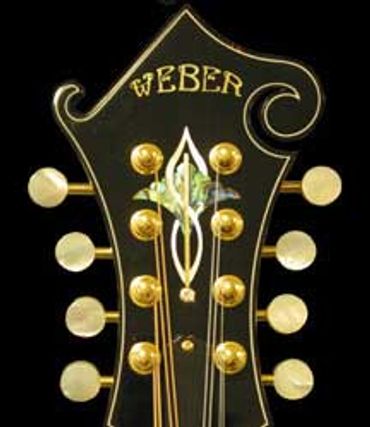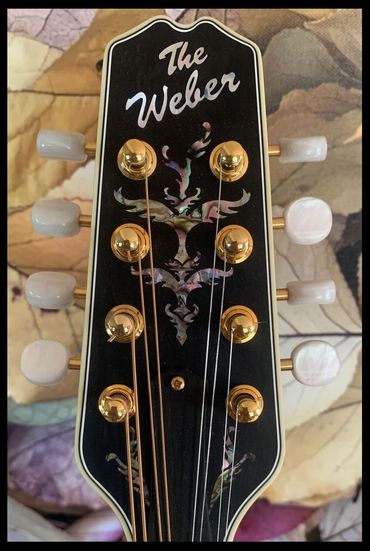Original Designs Created/Invented at Weber Mandolins
Original Brekke Bridge

The "Original Brekke Bridge " was a
new adjustable bridge for stringed instruments that was patented, trademarked and licensed exclusively
to Sound To Earth until 2001 when
Bridger Products, LLC took over sales.
Over the years, the original bridge has provided the only modern alternative to the standard Loar bridges of the 1920's.
Traditional Brekke Bridge

Although many dealers and players liked the Original Brekke bridge, some Weber dealers thought that a bridge that had a similar look and sound to the traditional Loar bridge would be easier to sell.
The Traditional bridge has a metal bar on the inside of the saddle that
prevents the saddle from sagging or breaking. The adjusting thumbscrew/nut rests on the base instead of under the saddle and it used an adjusting nut that was able to be adjusted under string pressure.
Mandola, Octave, Mandocello "S" Shaped Bridges

The Mola, Octave & Mandocello bridges in Original and Traditional styles presented a design challenge. The required intonation width was very wide and this made the bridge base fairly heavy and chunky. The "S" shape reduced the bridge weight and width significantly.
Maverick Electric Mandolin

As a machine guy, I felt that an electric mandolin could be a good addition to the Weber line because they are more machined than built. Bruce, as an acoustic guy, was marginally interested in the project but gave me the go ahead to research and build a prototype. Basic research was done by asking the mandolin community on Mandolin Cafe what they would like in an electric mandolin. The Maverick was a combination of the internet responses and some features that I thought would be cool: the three point shape and locating the controls under the pickguard.
The Sweet Pea Travel Mandolin

The Sweet Pea was a new concept that was initiated by a series of posts on Mandolin cafe: what mandolin would be appropriate for a child and when a piccolo mandolin came in for repair, the two concepts developed into an exercise in how much of a mandolin could be cut on a single CNC fixture. The body, neck and peghead are all cut as a single unit. This design included a new integral tailpiece that kept the top of the instrument uncluttered which seemed important for such a small instrument.
The Wood Nymph

The Wood Nymph was created when
an instrument came into the shop
for service and the installation of a pickguard. When I saw the instrument,it had a bunch of duct tape wrapped around the strings. I was told that the owner had just been in a recording session and the duct tape had been the solution to some recording problems. I thought that there could be a more elegant solution to the problem and that there was the opportunity for an inexpensive accessory that could be sold at trade shows and festivals. The Wood Nymph was the result. It was the first use of the phrase "Harmonic Suppressor" to describe something that reduced frequencies between the bridge and the tailpiece.
Guitar and Resonator Tailpieces

The Guitar, Resonator and
8-string Octar Tailpieces
These tailpieces were machined from brass and intended for use with ball end strings or hooked strings.
Weber Cast Tailpiece

The Weber cast tailpiece featured a ramp that would guide the strings up through the back openings and the string hooks. This design also included the addition of a rubber grommet and thumbscrew
to replace the traditional end pin. When I was designing the tailpiece, Bruce and the sales manager had just returned from a NAMM show where all of the instrument end pins had fallen out because of the change in humidity at the show. The grommet and thumbscrew were added to solve
that problem permanently.
The essential design was copied by Eastman mandolins after buying
20 from Weber.
The Armrest/Tailpiece

At Weber, we were having a lot of cast tailpieces that had flaws to the top that made them unusable. This armrest design re-used standard cast tailpieces that had casting or polishing flaws on the top surface.
Adding an armrest to the top of the tailpiece solved the defect problem
and allowed the armrest to float over
the top of the instrument. T
I thought that this arrangement would be better than using the violin clamps that were normally used on mandolin armrests.
The “Carousel” Soundwell

The “Carousel” Soundwell System for Resonator instruments
Bruce was having a hard time finding a source for the standard laminated wood soundwells and we didn't have the equipment to build our own.
He asked if I could design an alternative and the "Carousel" was the result.
Adjustable Resonator Bridge

This new bridge was the first adjustable bridge for resonator instruments.
It was a logical extension of the
Traditional Brekke Bridge to resonator instruments. All that it required was the design of new bridge bases.
It works for both the spyder cone and biscuit cone model resonators
Marketing Materials

Everything about the Wood Nymph was whimsical so an actual Wood Nymph Fairy seemed to be the perfect image for a hangtag.
Original Weber Peghead and Shell Designs
The first inlay design that I did for STE was the Big Sky Star for the Big Sky "F" model mandolin. The Celtic Cross was the second. Each one had matching fretboard markers. They were followed by the Celtic Clover for the mandola models, the Celtic Diamond for the octave models and the Celtic Torch for the mandocello models. As the mandolin models grew there was the Weber Fern, Bighorn Shield, Yellowstone Flowerpot, Maverick Spike, Soprano Barb, etc...
Some examples are shown below. Unfortunately, most custom designs were shipped before pictures were taken.









.jpg/:/cr=t:0%25,l:0%25,w:100%25,h:100%25/rs=w:370,cg:true)











Designed and Installed the Weber Pickguards



Copyright © 2025 Bridger Products, LLC - All Rights Reserved.